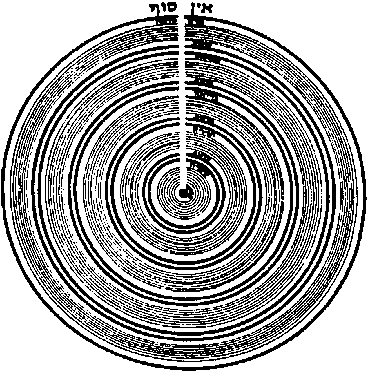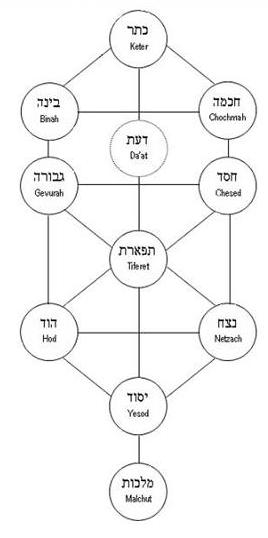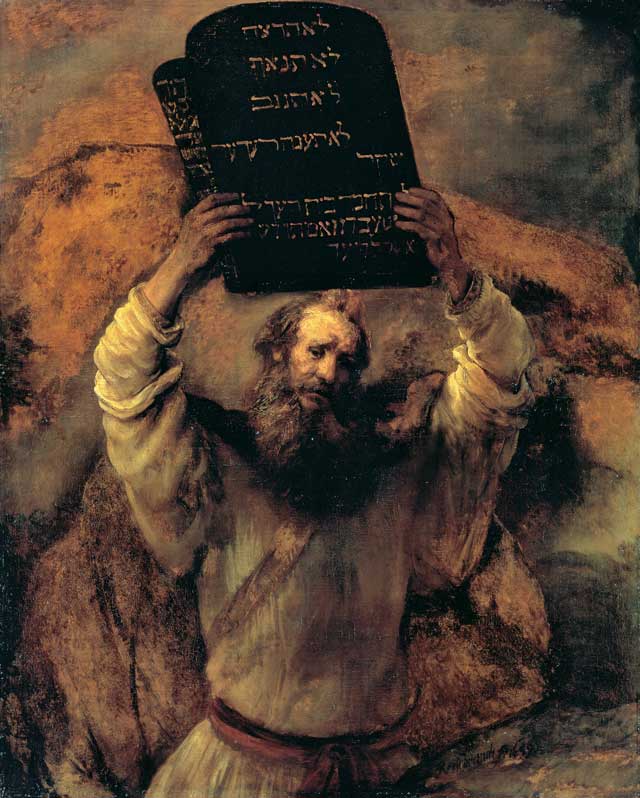And Moses turned, and went down from the mount, with the two tablets of the testimony in his hand; tablets that were written on both their sides; on the one side and on the other were they written. And the tables were the work of G‑d, and the writing was the writing of G‑d, graven upon the tables… And it came to pass, as soon as he came nigh unto the camp, that he saw the calf and the dancing; and Moses’ anger waxed hot, and he cast the tablets out of his hands, and broke them beneath the mount.
(Ex. 32:15-19)
The Torah portion Ki Tisa (Ex. 30:11-34:35) is, perhaps, has one of the most enigmatic episodes in the Torah—the breaking of the Tablets of the Covenant. The sin of the Golden Calf was, arguably, the lowest point in the Jewish history. One might think that the breaking of the Tablets of the Covenant was just as bad, if not worse. What right did Moses have to break the sacred Tablets given to him by G‑d? Moreover, according to Jerusalem Talmud, Moses wrestled these Tablets from G‑d:
The tablets were each six handbreadths long and three handbreadths wide. Moses held two handbreadths [of the tablets’ length], G‑d held two handbreadths, and in between were two handbreadths of space. Moses’ hands prevailed, and he grabbed hold of the tablets and broke them.
(Jerusalem Talmud, Taanit 4:5)
Moses even admits that he was acting on his own, on an impulse:
And I took hold of the two tables, and cast them out of my two hands, and broke them before your eyes.
(Deut. 9:17)
Sounds like high treason, does it not? And yet, astonishingly, G‑d not only endorsed this seemingly rebellious act but, according to Rashi, He thanked Moses for breaking the Tablets— “Be blessed for having broken them.” (See Talmud Tr. Shabbat 87a and Rashi there)
At the end of the Torah, after Moses passing, the Torah sums up his life:
And there hath not arisen a prophet since in Israel like unto Moses, whom the Lord knew face to face; in all the signs and the wonders, which the Lord sent him to do in the land of Egypt, to Pharaoh, and to all his servants, and to all his land; and in all the mighty hand, and in all the awesome things, which Moses wrought in the sight of all Israel.
(Deut. 34:10-12)
What are these awesome things? Using a homiletic rule for Torah interpretation called gazera shavah, Rashi proves that it was breaking of the Tablets that was considered one of the greatest things Moses has ever done! How do we understand that? Classical Biblical commentators and Chassidic masters offer a variety of interpretations that are well known. I would like to offer here a different interpretation based on the ideas of quantum field theory.
Just two days ago, on Shushan Purim, I posted here a short essay, “Purim—the Day when We Celebrate Spontaneous Symmetry Breaking,” in which I discussed a fundamental concept of quantum field theory—spontaneous symmetry breaking. In a nutshell, when a law of nature allows for two symmetrical solutions, but nature only chooses one of them, we call it spontaneous symmetry breaking. This mechanism is at the core of the unified theory of electroweak forces, as well as the Higgs Field, for example. For more details, I refer the reader to my most recent post on Purim and my earlier posts “Entangled Twins,” “Entangled Sisters,” and “Dreams of Pharaoh—a Lesson in Symmetry.”
Tablets of the Covenant (Luchot HaBrit, also known in English as Tablets of the Law, Tablets of the Testimony and Tablets of Stone) were symmetrical in many ways. Firstly, they were two rectangular stones of identical shape and size, i.e., they were symmetrically shaped so that one was a mirror image of the other. Each of the Tablets had writings engraved on both sides so that they could be read from either side—another symmetry. According to the sages of the Talmud, each Tablet contained an identical copy of the Decalogue—a symmetry making two Tablets indistinguishable. However, according to Rabbi Hanina ben Gamaliel, each Tablet had five of the Ten Commandments. And herein lays the most important symmetry.
According to the teachings of Kabbalah, there are several ways to arrange ten sephirot together. The first arrangement is Igulim, or “Circles” depicting sephirot as ever-smaller concentric circles representing the Ohr Soviv—the surrounding light:

Igulim
The arrangement reflecting the interactions of sephirot in the universe of Tikun, is Yashar, or “straight,” also called the Tree of Life, arranging sephirot into three columns, right, left and the middle:

Etz Chaim
Another arrangement closely related to the Yashar is an anthropomorphic arrangement in shape of a human body:
Lastly, ten sephirot can be arranged in two columns: five and five:
| Binah | Keter |
| Gevurah | Chochmah |
| Hod | Chesed |
| Yisod | Tiferet |
| Malchut | Netzach |
It is this arrangement that was represented in the Tablets of the Covenant (at least, according to Rabbi Hanina ben Gamaliel). This is a dynamic arrangement of the sephirot where there is much tension between the right column and the left column. In this arrangement there is no middle column; there is right and wrong, but there is no room for a compromise; there are innocent and guilty, but there is no room for mercy. In this arrangement, there is complete symmetry, pure judgment, but no forgiveness.
Moses realized that with the Tablets in his hands, Jews stood no chance. They were guilty as sin, and there would be no mercy for them. Jewish people were condemned for their betrayal. Thus, G‑d told Moses, “Now, therefore, let Me alone, that My wrath may wax hot against them, and that I may consume them.” Ex. 32:10.
On the spur of the moment, Moses did the unthinkable—he spontaneously broke the Tablets, thereby breaking the symmetry. This was spontaneous symmetry breaking in action! This symmetry breaking created the room for a compromise—for forgiveness. One cannot have kindness (chesed) to those who do not deserve it. However, one can still have mercy (rachamim, tiferet) even to those who do not deserve!
Indeed, right after this episode, G‑d revealed to Moses the Thirteen Attributes of Mercy:
And the Lord passed by before him, and proclaimed: ‘The Lord, the Lord, G‑d, merciful and gracious…
(Ex. 34:6-7)
As a result of the breaking of the Tablets, G‑d makes the eternal covenant with the Jewish people selecting them among other nations:
And He said: “Behold, I make a covenant; before all thy people I will do marvels, such as have not been wrought in all the earth, nor in any nation; and all the people among which thou art shall see the work of the Lord that I am about to do with thee, that it is tremendous.”
Ex. 34:10
In response to Moses spontaneously breaking the symmetry of the Tablets, G‑d spontaneously breaks the symmetry between the Jewish people and the other nations, selecting the Jewish people as his chosen nation.
When the second Tablets were given to Moses, he was instructed by G‑d to place them in the Arc of the Covenant together with the broken pieces of the first Tablets. This was to remind Jewish people, and, perhaps, G‑d as well, that the symmetry is broken forever, and that G‑d will be merciful and gracious to His people who will forever remain His chosen people.
Breaking the Tablets was emblematic of the spontaneous symmetry breaking as used in the quantum field theory. Steven Weinberg and a few other physicists received Nobel Prize for this. Doesn’t Moses deserve one too? He actually did—the Second Tablets, which were greater than the first!


“…In response to Moses spontaneously breaking the symmetry of the Tablets, G‑d spontaneously breaks the symmetry between the Jewish people and the other nations, selecting the Jewish people as his chosen nation…”
…as his chosen nation – or the nation that ‘chose’ to keep a covenant they had not even understood – we will do and we will hear – the ultimate bitachon! But also a great burden. No wonder they ‘yoked’ themselves to a golden aleph – looking for ‘instant’ reward or reward under ‘their’ terms.
“Thepit is empty , there is no water (בראשית לז:כג-כד) “והבור ריק אין בו מים Rashi: There was no water, but snakes and scorpion”s there were. The pit is the head, water is Torah. When there is no water/Torah in the head, there is snakes and scorpion”s.